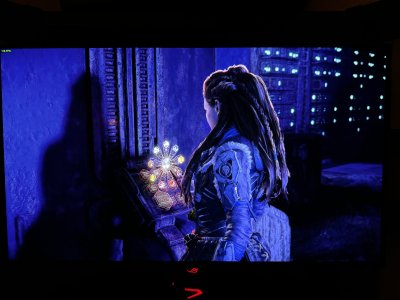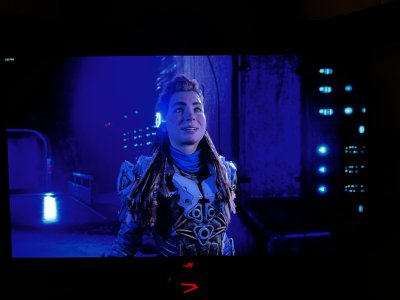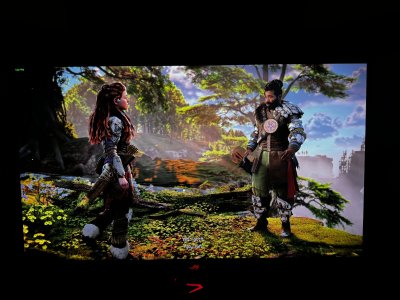Navigation
Install the app
How to install the app on iOS
Follow along with the video below to see how to install our site as a web app on your home screen.
Note: This feature may not be available in some browsers.
More options
You are using an out of date browser. It may not display this or other websites correctly.
You should upgrade or use an alternative browser.
You should upgrade or use an alternative browser.
ASUS Rog Swift 32 inch PG32UCDM with 31.5″ QD-OLED Panel, 4K 240hz
- Thread starter Comixbooks
- Start date
tftcentral review:
Bad news, unfortunately.The near black shadow detail was not great and it was hard to pick out very dark grey shades in this test image with box 6 being the first that was easy to distinguish before calibration. This is something that can often be an issue on OLED panels. We tried different options within the OSD menu and this was not possible to improve really in any meaningful way
yes although they also say that can be improved through calibration, and is also betterin HDR by defaulttftcentral review:
Bad news, unfortunately.
I'm starting to wonder if this is a QD-OLED problem. My TV is the same.tftcentral review:
Bad news, unfortunately.
MistaSparkul
2[H]4U
- Joined
- Jul 5, 2012
- Messages
- 3,524
The Instock Alert app isn't pinging me at all...guess it doesn't work on backorders.
JohnnyFlash
Limp Gawd
- Joined
- Apr 23, 2022
- Messages
- 154
The LG version has that new subpixel order, so maybe that's the winner after all.I'm starting to wonder if this is a QD-OLED problem. My TV is the same.
If you're not away and at a PC something like Distil is the only way. It's far faster than any of the alert apps.The Instock Alert app isn't pinging me at all...guess it doesn't work on backorders.
KickAssCop
[H]F Junkie
- Joined
- Mar 19, 2003
- Messages
- 8,331
Preordered this monitor. Ended up costing me 1634$ after taxes. Too expensive but I YOLO’d it. Will get maybe around 26-27 March.
Bigjohns97
[H]ard|Gawd
- Joined
- Oct 18, 2000
- Messages
- 1,249
I tried this on my s95b and didn't have the issue, what QD-OLED did you see this issue on?I'm starting to wonder if this is a QD-OLED problem. My TV is the same.
S95B. When I do the lagom black level test the first 5 squares are not any difference than off, even at close range. On my PG32UQX, even #1 is clearly visibly different from the background.I tried this on my s95b and didn't have the issue, what QD-OLED did you see this issue on?
KickAssCop
[H]F Junkie
- Joined
- Mar 19, 2003
- Messages
- 8,331
Got a notification that ASUS was in stock. Logged on and goned.
MistaSparkul
2[H]4U
- Joined
- Jul 5, 2012
- Messages
- 3,524
Once again Peak1000 mode sucks and people need to quit listening to reviewers who don't know what they're talking about:
https://www.reddit.com/r/OLED_Gamin...32ucdm_hdr_brightness_issue_tested_showcased/
https://rog-forum.asus.com/t5/gamin...de-hdr-issue/m-p/1005550/highlight/true#M1418

This isn't a "bug", it's just how Peak1000 mode works.

https://www.reddit.com/r/OLED_Gamin...32ucdm_hdr_brightness_issue_tested_showcased/
https://rog-forum.asus.com/t5/gamin...de-hdr-issue/m-p/1005550/highlight/true#M1418

This isn't a "bug", it's just how Peak1000 mode works.

MistaSparkul
2[H]4U
- Joined
- Jul 5, 2012
- Messages
- 3,524
Indeed! Oh well these QD OLED monitors are just a stop gap for me while I wait for the supposed RGB PHOLED from LG that's going to come in 2026. Unless of course that thing also ends up being a 400 nits HDR display too 
jbltecnicspro
[H]F Junkie
- Joined
- Aug 18, 2006
- Messages
- 9,547
I mean honestly, the best strategy is to get the best monitor tech you can given the time you have it, if it's available to you. LG CX owners and C1 owners can testify as 120hz BFI is no longer a thing for TV's and only recently just sprouted with the new ASUS monitor.
I think I'm going to stick with my 'spensive MiniLED. While I really would like something with less blur, I'm too addicted to the good HDR. Also still nervous about burn-in, though Monitors Unboxed is working on a good test for that. They are using the monitor for desktop/production daily workload at a reasonably high brightness setting. So it should help give a good idea of how long burn-in takes in a sort of worst case scenario and how bad it is.Indeed! Oh well these QD OLED monitors are just a stop gap for me while I wait for the supposed RGB PHOLED from LG that's going to come in 2026. Unless of course that thing also ends up being a 400 nits HDR display too
MistaSparkul
2[H]4U
- Joined
- Jul 5, 2012
- Messages
- 3,524
I think I'm going to stick with my 'spensive MiniLED. While I really would like something with less blur, I'm too addicted to the good HDR. Also still nervous about burn-in, though Monitors Unboxed is working on a good test for that. They are using the monitor for desktop/production daily workload at a reasonably high brightness setting. So it should help give a good idea of how long burn-in takes in a sort of worst case scenario and how bad it is.
PHOLED might be the solution. And if not then there is something else currently being researched: https://www.tomshardware.com/monito...ing-diodes-could-banish-oled-burn-in-for-good
Or perhaps the combination of both, so....insulated PHOLED?
Ya I'm watching all the OLED developments with great interest. I firmly believe that it is the future of displays and while they'll never eliminate the possibility of burn in (always going to be inherent to any emissive technology) they'll mitigate it to the point it doesn't matter.PHOLED might be the solution. And if not then there is something else currently being researched: https://www.tomshardware.com/monito...ing-diodes-could-banish-oled-burn-in-for-good
Or perhaps the combination of both, so....insulated PHOLED?
MistaSparkul
2[H]4U
- Joined
- Jul 5, 2012
- Messages
- 3,524
Actually it seems like fixing EOTF can be done via firmware update. But we'll have to wait and see how it plays out: https://twitter.com/TFTCentral/status/1773387664172953630
lagavulin
Gawd
- Joined
- Feb 5, 2022
- Messages
- 594
That could be said about a lot of things nowadays…vehicles, cellphones, videogames. Testing their own stuff just isn’t in the budget.Never understood why so many monitor manufacturers screw up EOTF. Like they don't test their own stuff before release. Is it really that hard?
That could be said about a lot of things nowadays…vehicles, cellphones, videogames. Testing their own stuff just isn’t in the budget.
Ya strange times indeed. Society has accepted unfinished/beta products as final purchases. And I see more and more of a trend of companies not honoring warranties. They simply ignore the customers request. So they can still publish warranties for marketing, but never have to actually follow through if they ignore all emails and put customers in phone loops. No one cares.
I think its a combination of things. People were less perceptive of issues monitors shipped with back in the day (or didn't care) + reviews were far less in depth. Add to this that products have gotten much more complex in terms of feature set and you have a recipe for disaster in that companies like Asus are trying to develop and support modern displays as if its still 2017 and the only thing to implement is VRR.
That is a big part of it for sure. Back in Ye Olde Thymes(tm) reviews just didn't cover most of this kind of shit, and people didn't know to be fussy about it. Like back in the CRT days there were basically zero reviews that included things like color gamut or EOTF. Those things existed and varied on CRTs, there were CRTs that did a better or worse job of Rec.709 /sRGB coverage and the EOTF, called gamma then, of screens could vary. But it just kinda was what it was and few, if any, reviews talked about it.I think its a combination of things. People were less perceptive of issues monitors shipped with back in the day (or didn't care) + reviews were far less in depth.
Even in the earlier LCD days places like TFTCentral were reviewing things like grayscale accuracy and gamma tracking, but few gamers seemed to give a shit. I had a professional NEC monitor that had good accuracy and you could calibrate it to be great, but very few people gave a shit. I was the weirdo, most people were after a gaming monitor.
It also has gotten WAAAAAY more complex. There's now an HDR setup, in addition to SDR, and often more than one mode for that (like VESA HDR400 vs native). In HDR there's all kinds of calculations and limiting that have to go on to not burn out the display, since it is literally going to be asked to do things it is not capable of. Then there's VRR and everything that comes with that, and multiple standards for it.
We are asking a lot more of monitors now than we used to.
jbltecnicspro
[H]F Junkie
- Joined
- Aug 18, 2006
- Messages
- 9,547
Uh huh.Never understood why so many monitor manufacturers screw up EOTF. Like they don't test their own stuff before release. Is it really that hard?
The performance expectation for "great" has also become a helluva lot more demanding. We used to be happy when our LCDs could do 5ms response times, now everything is put against OLED response times so basically no LCD is "great".I think its a combination of things. People were less perceptive of issues monitors shipped with back in the day (or didn't care) + reviews were far less in depth. Add to this that products have gotten much more complex in terms of feature set and you have a recipe for disaster in that companies like Asus are trying to develop and support modern displays as if its still 2017 and the only thing to implement is VRR.
HDR has just made it increasingly more demanding as "oh cool, gets really bright in SDR, I can use this in my home office with big windows" is no longer the expectation. I don't think most gamers actually care about HDR brightness anywhere near as much as people here. They are just happy to have big perceived contrast (true blacks) and vivid highlights that "pop", so any of these OLED monitors is going to be awesome to them.
For perspective, in the early 2000s I went through the whole lineup Viewsonic (when they were a more relevant brand) had for their best LCDs. I don't remember the model names anymore, but something like 21-24" models with maybe 1920x1200 resolution. I bought one, then after some time it stopped working. The company had a really good service where they just brought a new one to my door, and picked up the broken one at the same time. Then the new one failed, or had dead pixels or something, so by that time they had released a VA model so I got "upgraded" to that. That monitor had severe issues where it was impossible to calibrate for accurate colors, it had awful viewing angles and black crush problems. I then got their flagship IPS model and used that until upgrading to a Dell 30" 2560x1600 IPS - which had a very grainy AG coating in hindsight. I moved from that to the first 27" 144 Hz G-Sync 2560x1440 display.
Back then there wasn't even a whole lot of talk about CRT vs LCD performance, people were just happy that LCDs didn't take up their whole desk and had pixel perfect resolution and larger screen sizes. I don't miss having to go through several Samsung CRT models where you could not get the whole screen perfectly sharp or straight.
The only mini-LED FALD I have to put against my LG CX 48" OLED is the M2 Max Macbook Pro 16" (1600 nits peak, 1000 nits sustained) and if I play the same HDR video on it, I'm not unhappy about the OLED's brightness at all, even if I can see that the mini-LED does bring out more detail out of bright areas. For most games I'm just happy with the motion clarity of the OLED at 4K 120 Hz. Whenever I upgrade my TV, it's unlikely that I will go for a mini-LED model because the OLED is a better compromise to me.
Lava Lamp Freak
Limp Gawd
- Joined
- Jun 20, 2004
- Messages
- 426
View: https://www.youtube.com/watch?v=ulWv8Cfl-_4
Tom mentioned something I don't recall hearing in other reviews. The default option for PD is 65W, but there is an option for 90W PD. However, that option limits max brightness to 60%.
View: https://www.youtube.com/watch?v=ulWv8Cfl-_4
Tom mentioned something I don't recall hearing in other reviews. The default option for PD is 65W, but there is an option for 90W PD. However, that option limits max brightness to 60%.
Could this have been done to match energy regulations etc? Ie to be able to claim that the monitors does not consume more than XW at a given time etc.
KickAssCop
[H]F Junkie
- Joined
- Mar 19, 2003
- Messages
- 8,331
So I went to pick up this monitor. The shop was mindful of opening it up to check for dents/damages before sending me off with one. Unpacked it and to our surprise the monitor had scruff marks on both sides. Tried to clean with a cloth to no avail. Then confirmed it wasn't an extra film on the monitor. Further to my disappointment some dumbass at ASUS had put a "white sticker" on the fucking screen. Not the kind that peels off easy, the kind that has a tiny QR code and numbers on it. How fucked up is that. Glad the shop is good and they said they will send the monitor back and get back to me if they will get a replacement, otherwise it will be a refund. I knew people were complaining about screen having scratches and shit especially with Dells but to see it in real life am glad I bought locally rather than Newegg this shit.Preordered this monitor. Ended up costing me 1634$ after taxes. Too expensive but I YOLO’d it. Will get maybe around 26-27 March.
Buyer beware.
The white sticker is actually on a film that is really hard to spot. It has no tabs to peel. You can tell because the screen is way more reflective than it should be.So I went to pick up this monitor. The shop was mindful of opening it up to check for dents/damages before sending me off with one. Unpacked it and to our surprise the monitor had scruff marks on both sides. Tried to clean with a cloth to no avail. Then confirmed it wasn't an extra film on the monitor. Further to my disappointment some dumbass at ASUS had put a "white sticker" on the fucking screen. Not the kind that peels off easy, the kind that has a tiny QR code and numbers on it. How fucked up is that. Glad the shop is good and they said they will send the monitor back and get back to me if they will get a replacement, otherwise it will be a refund. I knew people were complaining about screen having scratches and shit especially with Dells but to see it in real life am glad I bought locally rather than Newegg this shit.
Buyer beware.
Lots of other people have made this same mistake.
KickAssCop
[H]F Junkie
- Joined
- Mar 19, 2003
- Messages
- 8,331
There was no film. We tried to check multiple times. I have asked the shop to try and see if there is one again.
Ok guy says there might be a film - so I am going to go and see. He wants me to be there before we peel it lol.
Ok guy says there might be a film - so I am going to go and see. He wants me to be there before we peel it lol.
Last edited:
KickAssCop
[H]F Junkie
- Joined
- Mar 19, 2003
- Messages
- 8,331
MistaSparkul
2[H]4U
- Joined
- Jul 5, 2012
- Messages
- 3,524
So it was our mistake and we couldn’t see the film. All setup now and best display I have ever used.
KickAssCop
[H]F Junkie
- Joined
- Mar 19, 2003
- Messages
- 8,331
After 2 days of use. This is the monitor I have been waiting for since 2020. Finally a monitor that isn't a complete disaster.
Only issue is sometimes in very specific situations there is some VRR flicker. Thus far I only saw it on COD MW3 menu screen (not persistent) and SF6 menu screen. Both screens are dark grey and it seems to be a known issue. Also given this is a Samsung panel, I expect a fix in about a year if they ever get around to it. Not a deal breaker and usually menus only last like 5 seconds.
Everything else though... :mindblown:
Only issue is sometimes in very specific situations there is some VRR flicker. Thus far I only saw it on COD MW3 menu screen (not persistent) and SF6 menu screen. Both screens are dark grey and it seems to be a known issue. Also given this is a Samsung panel, I expect a fix in about a year if they ever get around to it. Not a deal breaker and usually menus only last like 5 seconds.
Everything else though... :mindblown:
There is something to be said about the monitor market when that is the criteria to go by. This monitor kind feels like the LCD version of the LG OLED 42", not really best at anything but still a really good compromise.After 2 days of use. This is the monitor I have been waiting for since 2020. Finally a monitor that isn't a complete disaster.
Edit:
My bad, I thought I was in the Neo G9 57" thread. Would have been interesting to see if someone pointed out that this isn't a LCD
Last edited:
KickAssCop
[H]F Junkie
- Joined
- Mar 19, 2003
- Messages
- 8,331
I don’t have space for a 42 and I know it will cause me headaches. I think 32 is as high as I want to go and this monitor fits the bill.There is something to be said about the monitor market when that is the criteria to go by. This monitor kind feels like the LCD version of the LG OLED 42", not really best at anything but still a really good compromise.
KickAssCop
[H]F Junkie
- Joined
- Mar 19, 2003
- Messages
- 8,331
So I have had this for over a week and some change and this is the monitor to beat. Amazing colors, vibrant and detailed. No text fringing I can see. 240 Hz. Only issue is VRR flicker on grey backgrounds and loading screens (doesn't happen with grey in game). Not sure what will be the fix but for now, its not a problem that I can't live with. The upgrade from my G7 32 QHD 240 is massive.
Here is hoping I don't run into any issues and it keeps working as advertised.
Here is a photo of the box.

Here is hoping I don't run into any issues and it keeps working as advertised.
Here is a photo of the box.

![[H]ard|Forum](/styles/hardforum/xenforo/logo_dark.png)




